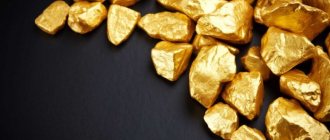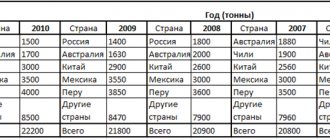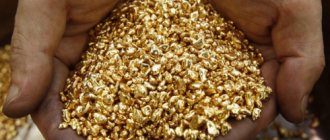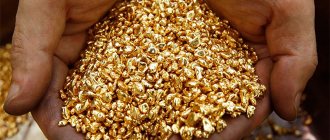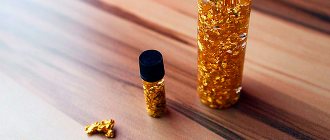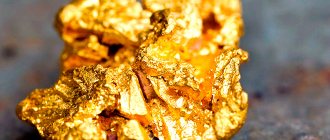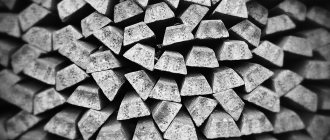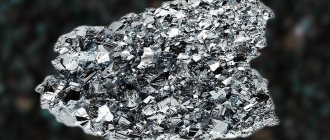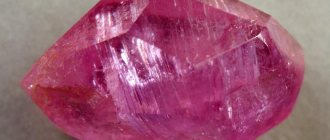Gold is an ancient, one of the rarest, noble yellow metal that people began to mine in the Neolithic era. Humanity began to use gold even before our era. But if now our first association with gold is luxury and jewelry, then before this was far from the case. First of all, gold was used as a tool for hunting animals. Spear tips were made from it.
Nowadays, gold is one of the main metals used in jewelry.
Physical and chemical properties of gold
Gold itself is a very soft metal by nature. It is very easy to scratch, and to avoid this, stronger metals are added to the composition at the time of jewelry production. For example, silver, copper or platinum. But the melting point of gold is more than a thousand degrees. This metal is also very ductile, which allows it to be forged into sheets with a thickness of only ~0.1 microns. This is called gold leaf. It also conducts heat well and is often used in cables.
Gold comes in different colors: just yellow, yellow with red shades, lemon yellow, white, pink, green and even blue. It depends on the composition of the metal. If you mix gold, silver and copper, you get yellow color. With more copper, the alloy will give a red tint. And if you add more silver, the mixture will turn lemon-colored.
Classification
The color ranges from silvery-white to golden-yellow and orange-red (white, yellow and rose gold, respectively).
There are a number of minerals that are known under the common related name "fool's gold" because people who have any knowledge of the nature of minerals cannot consider the following minerals to be gold. The most famous of them are sulfide and pyrite. Chalcopyrite, marcasite, and any gold-colored sulfide may be misleading to inexperienced mineralogists.
Chemical composition
The chemical formula of the mineral is Au. Jons Jakob Berzelius used the abbreviation Au from the Latin word aurum when he established the existing system of chemical symbols for the element.
Some minerals that contain gold in their formula belong to subclasses of sulfides known as tellurides. The mineral appears to be related to tellurium, one of the few elements with which it readily forms bonds. In fact, it is almost impossible to find specimens of tellurium without impurities of the precious metal. The tellurides are nagiagite, calaverite, sylvanite and krenite. All of them are sources of small amounts of gold.
Physical properties
The metal is virtually indestructible, which is why it has been reused since ancient times. Thus, the quantity of all reserves known in the modern world is almost equal to what has been mined over many centuries. Has the following physical properties:
- color: gold;
- shine: metallic;
- transparency: opaque;
- crystal structure: isometric; crystals create massive nuggets and crushed “flakes”; also form veins and crystal clusters;
- there is no splitting;
- cracks: jagged;
- feature: golden yellow, corresponds to the main color of the mineral;
- hardness on the Mohs mineral hardness scale: 2.5-3;
- specific gravity: 19.3 (extremely heavy even for metallic minerals);
- found in compounds with quartz, nagiagite, calaverite, sylvanite, krennerite, pyrite and other sulfides;
- conducts electricity;
- rock type – sedimentary, metamorphic;
- distinctive characteristics: plasticity, fusibility, knife-cut; color; high density; softness;
- low melting point (about 1063C).
Thus, thanks to its properties, a sheet of gold can be rolled out to a thickness of less than 0.00065 mm, and 1 ounce (28 grams) of mass can be stretched over a distance of more than 75 km.
Why is gold difficult to mine?
Illustration of gold mining by washing gold-bearing sand
Gold is a metal that, unfortunately, is almost impossible to extract, even if there is a considerable amount of it in the bowels of the earth. The difficulty of finding it is that it is scattered throughout the mine or the ocean floor. But at the same time it became the first metal that man found. Almost all gold is found in the metallic core of the earth, where it is extremely difficult to obtain. But nothing stands still, technology is improving, and over the past few years people have begun to mine many times more of this metal. It has been found in small rivers and even streams.
Types of deposits
Territories where gold lies on a scale sufficient for industrial mining are rare. Such places are called deposits. Also, a small amount of Au is found in deposits, placers, and ores.
Bedrock or ore deposits
Primary (primary, ore) accumulations appear in the mountains:
- In the deep layers of the planet, under the influence of high temperatures and strong pressure, the combination of chemical elements forms solutions of gold and quartz.
- Then the hot compounds move upward along cracks in the crust.
- Closer to the atmosphere, temperature and pressure drop, the shape of the aurum is destroyed, and the quartz crystallizes.
- The output is ore interspersed with gold. As a result of temperature changes, weathering, precipitation, and the actions of microorganisms and plants, the metal is gradually released.
Colluvial placer
Occurs on the surface during the destruction of primary gold deposits. It is also called secondary and is considered the least profitable for extraction.
Eluvial deposits
It is transported by water flows along river beds, and since aurum is one of the densest and heaviest metals, the metal settles and accumulates in suitable places. Placer gold can be found in the watersheds of major waterways in the form of debris and sand.
Residual deposits
These are Au grains formed as a result of weathering of a gold-bearing vein and located in close proximity to it.
Bottom sediments
The bottom of reservoirs consists of sedimentary formations - stones, sand, gravel, clay, lying on bedrock. As these materials are washed away from rocky terrain by large rainfall streams, depressions are formed in the riverbeds. Over time, the precious metal enters the water and settles in a pocket along with other masses, accumulates and creates bottom deposits.
Terrace deposits
Sometimes a river, having cut through the ground, goes down, and the old bottom remains above the water level. This is called a terrace. It can be directly above the channel or located at a distance from it. The deposits remain on it.
Where is gold mined?
Most gold mining is now done in the Republic of South Africa. In one year, experts can find more than five hundred tons of gold. For such a cosmic result, they have to dig through more than seven hundred tons of other various rocks. It also takes an incredible amount of water to wash the gold ore.
Gold mining is also carried out in China, the USA, Australia and Peru. Russia also has gold metal, but not so much. Chukotka, Krasnoyarsk Territory and Amur Region are specialized for its extraction.
History of origin and theory of the appearance of precious gold
Perhaps, noble gold has been considered the most valuable rock on planet Earth since time immemorial, because this rare and non-renewable resource of nature, which gradually entered human use, truly became known in the Iron Age of the Bronze Age.
When the ancient people of the ancient era of the golden age of the Greco-Roman civilization of medieval Mesopotamia believed that the round placers of native pieces of alluvial deposits of sparkling gold were accidentally found:
- on solid ground
- or in the sunny valley of a flat river,
created by the bright sun using the unique power of natural water.
Already in ancient times of the 4th century AD, the Holy Bible of the canonized scriptures of religious Christians briefly mentions the golden gifts brought by wise wise men from the Middle East to the pious baby who was born into the world, who later became the spiritual teacher Jesus Christ.
The name Aurum of the useful substance of gold from Latin means: the pre-dawn breeze, where the mythological deity of the morning dawn - the all-powerful Aurora on a winged chariot with a golden-colored solar halo above her head brought daylight from the heavenly stars to the sinful earth to all good people and almighty gods.
The modern theory of the origin of valuable gold claims that it appeared in the solar system under the influence of a nuclear explosion from the destruction of neutron stars.
Where, as a consequence, some of it condensed on the newly formed molten surface of the Earth, which is why most of the metal fossil is located in the hot core, which passed through the intermediate layer of the hot mantle.
However, the amount of useful gold that is located in the earth's crust was undoubtedly delivered to our planet in prehistoric times by the heavy bombardment of celestial bodies from cosmic asteroids, due to which the metallic rock ore spread over the entire surface of the earth, originating long before our era.
And now the Inca Empire collected the largest reserves of gold:
- for the cladding of temple complexes with precious plant fruits and the construction of a statue of the Sun God,
- for the production of household items, valuable bowls with decorated caskets and luxurious dishes with drinking vessels, a 700 meter chain and cash coins,
- for a military ransom and the creation of an altar throne in the form of a bloody altar chair,
where the molten metal of precious yellow gold was poured into the open throat during the death ceremony of the ritual sacrifice of an innocent being as a gift to the deity.
The basis of the cult belief of the highly developed civilization of the American continent of the pre-Columbian era was the widespread shedding of the blood of a pure being in the form of a man who, due to the fall of his ancestors, was able to please the holy spirit through a mortal test and thereby achieve final reconciliation with the divine creator, the Lord God.
Gold mining methods
There are several different ways to mine gold. Which method will be used depends on the type of deposit. Nuggets are obtained very simply - by washing. Using this method, a nugget was found that is considered one of the largest. His weight was 72 kilograms. And they found it only at a depth of five centimeters. Scattered gold is mined by dissolving in mercury. The regeneration method is used when the ore that contains gold contains a huge amount of other impurities. But this is a very difficult method that requires the introduction of high technology.
Where is the mined gold located?
Gold reserve storage
According to statistics, almost all the gold found, specifically 90%, is in the bank. It can also be kept by private individuals under the guise of jewelry. Only 10% of all mined metal remains for industry.
In the world list in terms of the volume of gold held in state reserves, the leader is the United States. As of 2021, the US gold reserve is more than 8.1 thousand tons. Russia, with gold reserves of about 2.3 thousand tons, is in 5th place in this ranking.
Combinations with other stones
Gold can be combined with almost any stone or crystal.
To enhance calming or anger-controlling properties, choose gold jewelry with howlite, agate, colemanite, citrine, lepidolite, bronzite, lithium quartz, blue quartz, aragonite, smoky quartz, or magnetite.
To increase its healing properties, it is necessary to combine the mineral with sapphires, pink chalcedony, hematites, spinels, rhodochrosites, moonstones, sugilites, lepidolites or tourmalines.
